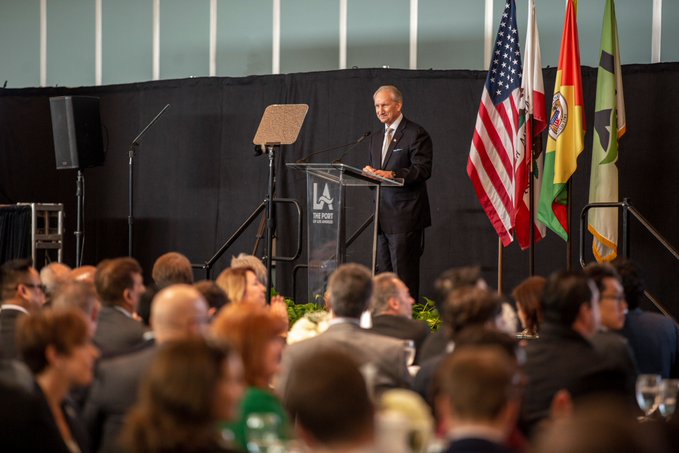
-
Port of Los Angeles’ nearly 10-million-TEU throughput in 2022 was the second highest in its 115-year history and made it the US’ busiest hub for the 23rd consecutive year
-
LA Port executive director Eugene Seroka pledged to focus on economic growth and job creation to improve the quality of life for port communities and promote sustainable, zero-emission operations
-
The port kept the No.1 post it lost to Port of New York and New Jersey last August, September. October and November as retailers shifted imports to East Coast gateways
Port of Los Angeles is still the busiest US hub for the 23rd consecutive year, handling 9.91 million twenty-foot equivalent units (TEUs) of containers in 2022, the second highest in its 115-year history. In June 2021, the port recorded its highest-ever volume of 10.68 million TEUs.
A beaming Eugene Seroka, Port of LA executive director, announced the achievement in his State of the Port address on January 19 at the annual Pacific Merchant Shipping Association event attended by more than 500 city officials, business executives and community members.
The port retained the No.1 title it lost to Port of New York and New Jersey last August, September, October and November, when retailers shifted their import cargoes to East Coast ports since last June due to congestion and labor concerns at the West Coast hubs.
RELATED READ: LA port November box throughput drops 21%
Seroka outlined priorities for 2023, pledging to focus on economic growth and job creation, improving the quality of life for surrounding port communities, and furthering sustainable, zero-emission business operations.
“Over the past few years, as we’ve risen to each and every challenge, we have become a stronger, more resilient port,” Seroka said.
“The capabilities that we developed during that time have positioned us well to grow our market share, fulfill our commitment to create jobs and build a better quality of life for our communities.”
Seroka said the port will continue to lead technology innovation in the maritime industry to drive further efficiency and be still the busiest US hub. He announced new features of its Port Optimizer™ digital tracking portal that includes providing exporters more predictability and tracking capability on exports.
He cited the economic benefits of the rebounding cruise industry, saying that after shutdowns during the COVID-19 pandemic, cruise ship sailings at the port grew to 229 from 61 in 2021.
“That’s an economic benefit of a quarter billion dollars to our local communities and LA’s tourism economy,” Seroka said, adding that such economic benefits feed into the overall quality of life and opportunities for communities surrounding the port.
He cited the port’s initiatives to improve the quality of life, job creation and sustainability in surrounding communities. These include the Public Access Investment Plan (PAIP), which has funded since 2015 nearly US$234 million in new public-serving waterfront infrastructure, including roadways and public promenades, for the use of the communities.
Progress on several major public access projects will continue in 2023, including the debut of the $71 million Wilmington Waterfront Promenade in April, Seroka said.
The Port of Los Angeles Workforce Initiative will focus on providing career and economic opportunities for a broad range of workers, while the Goods Movement Training Campus, set up in collaboration with Port of Long Beach and the California Workforce Development Board, will provide worker skill development, upskilling and reskilling for port-specific jobs.
The port has given top priority to sustainability and environmental programs in 2023, including continued planning for new “green shipping corridors” with the ports of Shanghai and Singapore to cut carbon emissions along these critical trade routes.
It also continues to develop and deploy zero-emission cargo-handling and other equipment, as well as deploy more clean trucks funded by the Clean Truck Fund Rate.
Seroka said Port of LA will be part of a statewide coalition that will apply for a $1.4 billion US Department of Energy grant to establish a green hydrogen hub at the San Pedro Bay port complex.




